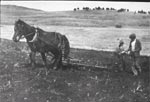| As early as the 1820s, before the arrival of the Jesuit Missionaries, the Schitsu’umsh had begun cultivating their first domesticated crop - the potato. It is likely that in contact with fur traders from Fort Spokane that the art of potato farming had been learned. It is, after all, a skill not unlike the annual digging of camas and bitterroot. While continuing to move with the changing seasons to hunt, fish, gather berries and dig for roots, the Schitsu’umsh gradually integrated farming into their lives. By the 1890s they had become some of the most successful farmers in the Inland Northwest. Using state-of-art farm equipment, each Schitsu’umsh family had from several hundred to 2,000 acres of fenced-land under cultivation. In 1894, the entire reservation's production of one of the crops, wheat, was 100,000 bushels. In addition, oats, peas and hay for cash income were grown. Families typically had two homes, one on their farm and one in DeSmet, where families gathered each weekend to celebrate Mass and socialize. It was not uncommon to see Indian landowners hire non-Indian laborers to assist with the farming activities.
|
|
Alice Koskela, Legal Counsel for the Coeur d'Alene Tribe, discusses the nature of land ownership on the reservation, of which an understanding the Dawes Act, also known as the Allotment Act, is critical. It is this act which opened up the reservation for white settlement and resulted in tremendous loss of Indian owned land. Part 1 (interviewed and edited by Rodney Frey, August 2002)
|
In 1887 the U.S. congress enacted the General Allotment Act, also known as the Dawes Severalty Act, which sought to "civilize and make farmers" of the Indian Tribes throughout the United States. Each individual Indian would be "given" 160 acres of land, instilling the value of "private ownership" and helping bring about their self-sufficiency. As there was considerable pressure to "open-up" the reservations for white settlement, the remaining tracks of land would then be available for suyepmsh occupancy. In violation of the Agreement of 1889 (which held that no reservation lands could be sold or occupied by whites without the consent of the Tribe), the allotment of the Coeur d'Alene Reservation had been completed by 1909. A total of some 104,000 acres remained in the hands of 638 Indian and "adopted" members of the Tribe, while 310,000 acres of "surplus" reservation land was lost, without compensation to the Tribe. See map (allotments in dark gray shading).
|
|
Alice Koskela continues discussing the Dawes Act, considering such issues as "fee" and "trust" lands, the "checkerboard" pattern of land ownership, the challenges in jurisdictional authority, and the resulting "unwanted dependency" on the federal government. Part 2
|
In addition, the Allotment Act imposed a policy of equitable land inheritance - each child was to inherit equal shares of a parcel of land. Within a few generations, a "checkerboard" pattern of landownership resulted. Any given acre of land could be owned by numerous, potentially unrelated individuals, thus rendering the fragmented and scattered lands economically unviable. Poverty replaced once productive family farms. As Felix Aripa once commented, "It broke every one of them." An Act that sought self-sufficiency for the Indian accomplished just the opposite. The legacy of the imposed dependency is still felt today.
|
|
Alice Koskela continues discussing the effects of the Dawes act, especially its inheritance policy and the resulting "splintering" of the land into economically ineffective units. For example, a single person might be left with a 11/1728th interest in a 160 acre parcel of land! Part 3
|
In 1911 that last remaining Schitsu'umsh families residing close to Lake Coeur d'Alene were evicted from their homes. Heyburn State Park was established at the southern end of Lake Coeur d'Alene, along the shores of Chatkolet and Benewah Lakes. The $11,000 intended for compensation to the Tribe was used by the State of Idaho to help cover the costs of developing a park to be used primarily by the white residents of the state.
© Coeur d'Alene Tribe 2002
< previous |
next >
|










